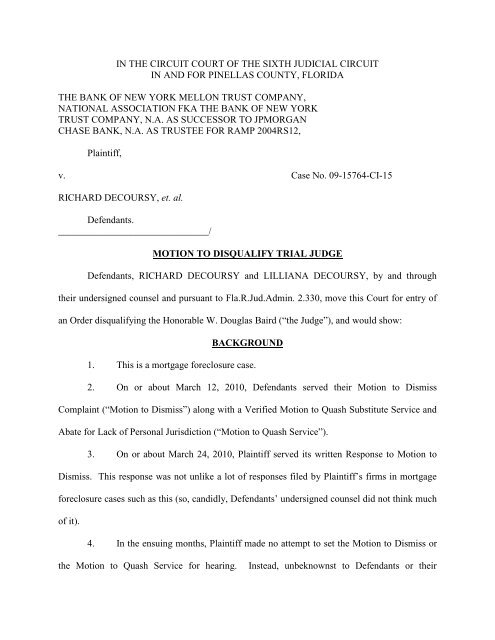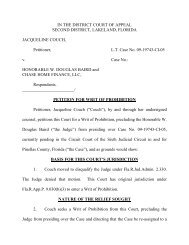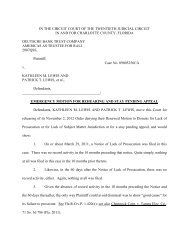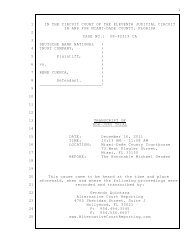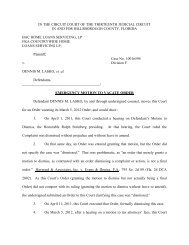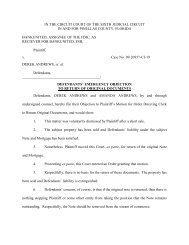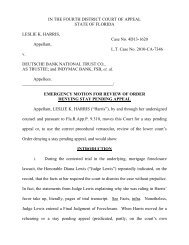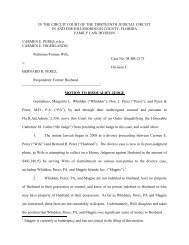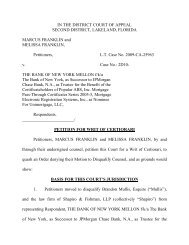Motion to DQ Judge - Stopa Law Firm
Motion to DQ Judge - Stopa Law Firm
Motion to DQ Judge - Stopa Law Firm
- No tags were found...
You also want an ePaper? Increase the reach of your titles
YUMPU automatically turns print PDFs into web optimized ePapers that Google loves.
IN THE CIRCUIT COURT OF THE SIXTH JUDICIAL CIRCUITIN AND FOR PINELLAS COUNTY, FLORIDATHE BANK OF NEW YORK MELLON TRUST COMPANY,NATIONAL ASSOCIATION FKA THE BANK OF NEW YORKTRUST COMPANY, N.A. AS SUCCESSOR TO JPMORGANCHASE BANK, N.A. AS TRUSTEE FOR RAMP 2004RS12,Plaintiff,v. Case No. 09-15764-CI-15RICHARD DECOURSY, et. al.Defendants._______________________________/MOTION TO DISQUALIFY TRIAL JUDGEDefendants, RICHARD DECOURSY and LILLIANA DECOURSY, by and throughtheir undersigned counsel and pursuant <strong>to</strong> Fla.R.Jud.Admin. 2.330, move this Court for entry ofan Order disqualifying the Honorable W. Douglas Baird (“the <strong>Judge</strong>”), and would show:BACKGROUND1. This is a mortgage foreclosure case.2. On or about March 12, 2010, Defendants served their <strong>Motion</strong> <strong>to</strong> DismissComplaint (“<strong>Motion</strong> <strong>to</strong> Dismiss”) along with a Verified <strong>Motion</strong> <strong>to</strong> Quash Substitute Service andAbate for Lack of Personal Jurisdiction (“<strong>Motion</strong> <strong>to</strong> Quash Service”).3. On or about March 24, 2010, Plaintiff served its written Response <strong>to</strong> <strong>Motion</strong> <strong>to</strong>Dismiss. This response was not unlike a lot of responses filed by Plaintiff’s firms in mortgageforeclosure cases such as this (so, candidly, Defendants’ undersigned counsel did not think muchof it).4. In the ensuing months, Plaintiff made no attempt <strong>to</strong> set the <strong>Motion</strong> <strong>to</strong> Dismiss orthe <strong>Motion</strong> <strong>to</strong> Quash Service for hearing. Instead, unbeknownst <strong>to</strong> Defendants or their
undersigned counsel at the time, Plaintiff’s counsel submitted some sort of correspondence <strong>to</strong>this Court, ex parte (either in writing or via telephone) without providing a copy <strong>to</strong> Defendants’counsel and without informing Defendants’ counsel. Via this correspondence, Plaintiff’s counselrequested that the <strong>Judge</strong> deny the <strong>Motion</strong> <strong>to</strong> Dismiss, ex parte, without notice, and without ahearing.5. On August 19, 2010, Defendants’ counsel received a written Order denying the<strong>Motion</strong> <strong>to</strong> Dismiss in the mail. The Order was contained in an envelope with a return addresslabel of Plaintiff’s counsel. Prior <strong>to</strong> this time, Defendants and their counsel had no idea that the<strong>Judge</strong> had been given any correspondence or would even be entertaining the possibility of rulingon the <strong>Motion</strong> <strong>to</strong> Dismiss without a hearing. The Order came, quite simply, completely out ofthe blue.6. Notably, the <strong>Judge</strong> denied the <strong>Motion</strong> <strong>to</strong> Dismiss without a hearing, and directedDefendants <strong>to</strong> file an Answer, yet the <strong>Judge</strong> completely ignored the <strong>Motion</strong> <strong>to</strong> Quash Service,acting as if it did not exist.I. THE JUDGE’S EX PARTE COMMUNICATIONS WITH PLAINTIFF’SCOUNSEL REQUIRE HIS DISQUALIFICATION.7. Under a well-established line of Florida cases, where a judge participates in exparte communications with opposing counsel, his disqualification is required. As the FloridaSupreme Court has explained:Canon 3B(7) of the Code of Judicial Conduct provides that "[a] judge shall notinitiate, permit, or consider ex parte communications, or consider othercommunications made <strong>to</strong> the judge outside the presence of the parties concerninga pending or impending proceeding." Based on this principle, this Court hasrepeatedly stated that there is nothing "more dangerous and destructive of theimpartiality of the judiciary than a one-sided communication between a judge anda single litigant." …We are not concerned with whether an ex parte communication actuallyprejudices one party at the expense of the other. The most insidious result of ex2
parte communications is their effect on the appearance of the impartiality of thetribunal. The impartiality of the trial judge must be beyond question.State v. Riechmann, 777 So. 2d 342 (Fla. 2000); see also Smith v. State, 708 So. 2d 253 (Fla.1998); Pearson v. Pearson, 870 So. 2d 248 (Fla. 2d DCA 2004) (“Petitioner’s allegation of an exparte communication alone established a reasonable basis <strong>to</strong> fear she would not receive a fairhearing in subsequent proceedings.”).8. Here, the <strong>Judge</strong> communicated with Plaintiff’s counsel, ex parte, regarding the<strong>Motion</strong> <strong>to</strong> Dismiss and the Order denying said motion. To illustrate, Defendants’ undersignedcounsel did not even know the Order had been submitted <strong>to</strong> the Court, or that such an Order waseven a possibility (without a hearing or otherwise) until after the <strong>Judge</strong> signed it. The fact thatservice copies of the Order were provided in envelopes of Plaintiff’s counsel proves the <strong>Judge</strong>did not do this on his own – there absolutely was an ex parte communication.9. The issue here is not just that the <strong>Judge</strong> denied the <strong>Motion</strong> <strong>to</strong> Dismiss without ahearing. The issue is that the <strong>Judge</strong> communicated with Plaintiff’s counsel about the <strong>Motion</strong> <strong>to</strong>Dismiss and the Order thereon ex parte. Respectfully, even if he thought the Order could beentered without a hearing, the <strong>Judge</strong> was prohibited from communicating with Plaintiff’s counselex parte. These ex parte communications require the <strong>Judge</strong>’s disqualification. See cases, supra.II.THE JUDGE’S ORDER, ENTERED WITHOUT NOTICE, WITHOUT AHEARING, AND WITHOUT REGARD FOR DEFENDANTS’ MOTION TOQUASH SERVICE, REQUIRES HIS DISQUALIFICATION.10. Defendants’ undersigned counsel recognizes that it is theoretically possible for ajudge <strong>to</strong> adjudicate a motion <strong>to</strong> dismiss without a hearing. Federal court judges do this all of thetime. The fundamental difference, though, and the fatal problem with the <strong>Judge</strong>’s actions in thiscase, is that, in those courts, there is a system in place for the adjudication of such a motionwithout a hearing, so the parties are aware of the possibility and can draft their motion3
accordingly.11. Here, Defendants and their counsel had no idea that this Court was consideringthe entry of an Order on the <strong>Motion</strong> <strong>to</strong> Dismiss without a hearing. There is no procedure in placefor this Court <strong>to</strong> engage in such an act. There is no Administrative Order or rule of procedureauthorizing this conduct. Had there been, Defendants’ counsel would have taken more time inthe drafting of the motion, <strong>to</strong> include more legal citations. Defendants’ counsel did not includesuch citations because he thought Defendants would be afforded a hearing, as has alwayshappened on motions <strong>to</strong> dismiss in Pinellas County cases. Quite simply, there is an enormousdifference in how an at<strong>to</strong>rney drafts a motion when he/she believes he will have oral argumen<strong>to</strong>n the motion and how an at<strong>to</strong>rney drafts a motion when the Court is going <strong>to</strong> rule on the motionwithout oral argument. To ignore this distinction, and enter an ex parte Order without a hearingand without notice that there would be no hearing, is a denial of due process and is patentlyunfair. This causes Defendants <strong>to</strong> harbor a well-reasoned fear that the <strong>Judge</strong> is not neutral anddetached. See Marvin v. State, 804 So. 2d 360 (Fla. 4th DCA 2001); Barnett v. Barnett, 727 So.2d 311 (Fla. 2d DCA 1999); Wargo v. Wargo, 669 So. 2d 1123 (Fla. 4th DCA 1996).12. Accentuating Defendants’ concerns is the fact that the <strong>Judge</strong> directed Defendants<strong>to</strong> file an Answer within 20 days even though the <strong>Motion</strong> <strong>to</strong> Quash Service is pending.Respectfully, this is why hearings should be conducted and both sides given a chance <strong>to</strong> beheard. After all, under well-established law, Defendants cannot be made <strong>to</strong> answer when their<strong>Motion</strong> <strong>to</strong> Quash Service has yet <strong>to</strong> be adjudicated.13. The fact that the <strong>Judge</strong> has directed Defendants <strong>to</strong> answer, without givingDefendants a chance <strong>to</strong> be heard and without considering Defendants’ <strong>Motion</strong> <strong>to</strong> Quash Service,gives Defendants a well-reasoned fear that the <strong>Judge</strong> is not neutral and detached. To illustrate, is4
the <strong>Judge</strong> really going <strong>to</strong> give Defendants a fair hearing on the <strong>Motion</strong> <strong>to</strong> Quash Service when hehas ignored that motion and, proceeding ex parte and without notice or hearing, directed them <strong>to</strong>file an Answer? Defendants’ belief that he would not be fair is eminently reasonable.14. Of course, <strong>to</strong> the extent the <strong>Judge</strong> knew the <strong>Motion</strong> <strong>to</strong> Quash Service was pendingbut entered the Order anyway, his bias against these Defendants is even more apparent. Eitherway, disqualification is required. See cases, supra.III.IT APPEARS THE JUDGE DID NOT EVEN EVALUATE THE MOTION TODISMISS, AS HIS ORDER DENYING IT WAS MERELY A FORM ORDER.15. The Order denying the <strong>Motion</strong> <strong>to</strong> Dismiss is a form, drafted, apparently, byPlaintiff’s counsel. Significantly, it is exactly the same, verbatim, as Orders entered in othercases by this same judge. Respectfully, where the <strong>Judge</strong> is signing form Orders in a myriad ofcases, with the same language, even though the <strong>Motion</strong>s <strong>to</strong> Dismiss in these cases are not thesame, Defendants have a well-reasoned fear that the <strong>Judge</strong> did not evaluate the <strong>Motion</strong> <strong>to</strong>Dismiss on the merits. This may sound harsh, but if the judge was truly evaluating each motionon its merits, on a case-by-case basis, then the Orders should not be the same (in different cases).16. To illustrate, the <strong>Motion</strong> <strong>to</strong> Dismiss in this case contains arguments that Plaintifflacks capacity <strong>to</strong> sue and Plaintiff failed <strong>to</strong> attach the promissory note upon which this lawsuit isbased. This latter argument requires dismissal under the Florida Supreme Court’s approved formfor mortgage foreclosure cases, yet the <strong>Judge</strong> completely disregarded this issue in the Order (justas he ignored the issue of capacity). Failing <strong>to</strong> attach a Note <strong>to</strong> the Complaint in a foreclosurecase requires dismissal, yet in his haste <strong>to</strong> deny the motion, ex parte and without a hearing, the<strong>Judge</strong> completely ignored this bona fide argument.17. The foregoing facts, individually and collectively, cause Defendants <strong>to</strong> harborwell-reasoned fears that the <strong>Judge</strong> is not neutral and detached. Disqualification is required.5
WHEREFORE Defendants respectfully request that this Court enter an Orderdisqualifying the Honorable W. Douglas Baird from presiding over this cause.CERTIFICATE OF GOOD FAITHDefendants’ counsel, Mark P. S<strong>to</strong>pa, Esquire, hereby certifies that the instant motion andthe statements set forth herein are made in good faith.____________________________________Mark P. S<strong>to</strong>paUnder penalty of perjury, I declare that I have read the foregoing document and that thefacts stated in it are true.VERIFICATION____________________________________Lilliana DecoursyCERTIFICATE OF SERVICEI HEREBY CERTIFY that a true and correct copy of the foregoing has been furnishedvia U.S. Mail <strong>to</strong> Honorable W. Douglas Baird, 315 Court Street, Room and Nikolay Kolev, Esq.,P.O. Box 25018, Tampa, FL 33622-5018 on this ____ day of August, 2010.Mark P. S<strong>to</strong>pa, Esquire______________FBN: 550507STOPA LAW FIRM2202 N. West Shore Blvd.Suite 200Tampa, FL 33607Telephone: (727) 667-3413ATTORNEY FOR DEFENDANTS6


